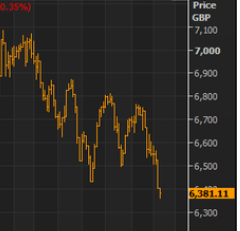 All part of life’s ups & downs, nothing to see here
All part of life’s ups & downs, nothing to see here
Yesterday Wall Street Wolf guest Bill Bonner was pointing the finger at US retail sales in a very persuasive manner:
‘Recent sales figures from America’s retailers show how deep the rot has become. Sales have been rising at an alarmingly slow rate – just 0.5% since 2007.
Between 2000 and 2007, they went up four times as fast. In the 1990s recovery, they went up six times as fast.
Especially rotten are sales at America’s four largest mall retailers – Macy’s, Kohl’s, Sears, and JCPenney. Together, their sales are falling at a 10% rate per year… or four times faster than the fall in department store sales generally.
What is interesting about these four companies is that they have been among the most aggressive of the stock market manipulators. Between 2005 and 2014, they earned a combined total of $13 billion. But their top execs spent $34 billion deceiving investors about the true value of their firms, by way of share buybacks, pocketing billions for themselves in the process.’
Today, I’m able to do the same for UK retail. This is the sector the Conservatives always turn to when everything else is giving the game away. In net terms, multiple retailing actually worsens the UK trade gap because a huge proportion of what it sells is imported; but because it usually sounds sort of solid (and nobody big has as yet gone bankrupt) Camerlot love to quote it. Something tells me today might be an exception.
Versus a year ago, July retail sales were up 4.2%. Not bad at all. However, month on month sales were nearly static at 0.1% – four times less than expected by the consensus of economists. And of course, share is moving away from the big old brands towards the foreign owned price-cutters…more lost income for UKplc, and, um, not terribly consistent with a recovery during a good summer month.
Nobody’s bankrupt yet because everyone in every form of distribution can keep whacking QE and Zirp non-trading profits to the bottom line. And to date, that same stimulant QE (that has yet to stimulate anything beyond the stock market) has kept the FTSE rising happily atop a fountain of wee-wee.
But since May, the truth about debt, export balance and China has started to sink in. This chart show that gradually developing series of slumps and half-hearted rallies:
 At 6381, the FTSE is now in correctionland. Oh dear, and it was all going so well. Especially in China, says Android Eaven-Elpus at the Telegraph, because business confidence there is now zooming up. But confidence is a fickle mistress, and not quite as mind-concentrating as a plummeting stock market.
At 6381, the FTSE is now in correctionland. Oh dear, and it was all going so well. Especially in China, says Android Eaven-Elpus at the Telegraph, because business confidence there is now zooming up. But confidence is a fickle mistress, and not quite as mind-concentrating as a plummeting stock market.
There was huge relief yesterday when the Politburo (having banned nearly 50% of all selling in the markets) stepped in and started buying everything. In this the era of free markets, it’s important to have all the bases covered, and sure enough the Shanghai Composite rose 1.2%. If it hadn’t, to be honest, we’d have been searching for a poltergeist, but either way the euphoria stopped abruptly overnight, when the index fell 3.4%.
But even if the UK’s retail scene is a little patchy, surely more people have the security to spend now given that unemployment is falling under Camerlot? Ah but ah but yes but no but, as thousands of us have been yelling to the deaf voters for three years, people don’t have enough work or get paid anywhere near enough for it. Here’s a chart showing this rather conclusively:
 In a nutshell, what this shows is that household debt for the young and the old has doubled in nine years, and accelerated since the 2010 Election in all households….except the 55-64s.
In a nutshell, what this shows is that household debt for the young and the old has doubled in nine years, and accelerated since the 2010 Election in all households….except the 55-64s.
I suppose this is why the DWP of IDS has to make everything up. But one thing not made up is the speed with which The Slog’s prediction of Asian retaliation to China’s Yuan has come true: Kazakhstan devalued the Tenge by 4.5% today, the Turkish lira dropped 1.3%, the Vietnamese Dong 1.2%, the Korean Won over 2.5%, the Indian Rupee 1.5%, Taiwanese dollar 1.2%, Malaysian Ringgit 2.7%, and the Indonesian Rupiah 1.4%.
What can a chap say, other than “Yuan Kazahk Stan are going to need an inflating Dong to do the Tenga before anyone can Ringgit, shout ‘Rupee!’ and say they Won over the Lira”.
Sorry. The more time goes on, the harder I find it to take much of this seriously.




